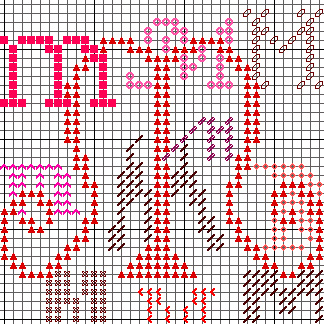
If you like vintage books and projects, as I do, often you will find that they call for mesh sizes you can’t find.
Projects from the 1970’s often want 10 or 12 mesh. These days 10-mesh is almost impossible to find, although it’s still made. 12 mesh is easier to find, but often isn’t stocked by shops. Most of our needlepoint is done on 18 mesh, with significant fractions done on 13 and 14 mesh.
Projects from guilds and seminars are often done on Congress Cloth, which is 24 mesh. If you have a hard time seeing it, I do, you might want to change the mesh to 18.
Making a change to mesh shouldn’t be a challenge, but often it is. That’s because we don’t know what effects making this change will have. Do it right, and you will be able to make charted and drawing projects on the canvas mesh you chose with ease.
Size of Project
If you change mesh size, the finished size of your project will change. If your mesh is smaller than the suggested mesh, your project will be smaller as well.
If the overall thread count is listed on the project, finding the finished size just needs simple math. Divide the number of threads by the mesh size and you have your new dimensions.
If all you have is a size in inches, you’ll need one more step. Multiply the size by the recommended mesh to get the thread count, then do the division.
Remember to cut your canvas 2″ bigger all around!
Size of Drawing
Many older projects, projects in magazines, and some guild projects begin with a line drawing. You will need to enlarge or reduce the drawing for the new mesh. To do this requires finding the percentage difference (more math). To find the percentage difference in mesh:
- Work out the difference (increase) between the old and new mesh sizes you are comparing.
- Divide the increase by the original number and multiply the answer by 100.
If your answer is a negative number then this is a percentage decrease. I often eyeball this. 18 mesh is 1/3 bigger than Congress Cloth, while it 80% smaller than 10 mesh. 13 mesh is 30% smaller than 10 mesh, and close to twice as big as Congress Cloth. Doing these rough estimates is usually good enough.
Now apply the number to making your copy of the drawing. If the number you got from your calculation is positive, add it to 100% to get the new size. If the number is negative, subtract that number from 100 to get the size for the reduction.
After making your copy use it to transfer the pattern to canvas.
Threads Used
Once you have your canvas and drawing the size your project needs, you are faced with what is the biggest hassle for stitchers: what threads to use?
Often threads called for are no longer made (I’ll cover this in an article later this week). In other cases the thread is still available but is the wrong size.
There are two simple guidelines for changing threads when you change mesh sizes.
If the thread is stranded, add or subtract strands to get the size that fits the canvas.
If the thread comes in sizes go up or down sizes to get the correct size.
If neither of these applies and the new mesh is much different, try the thread on a doodle cloth. Actually you should always test the thread/stitch combination on a doodle cloth before beginning the project to be sure it works for you. Do this with stash threads so you can be sure you buy the correct size and amount of thread.
About Janet M Perry
Janet Perry is the Internet's leading authority on needlepoint. She designs, teaches and writes, getting raves from her fans for her innovative techniques, extensive knowledge and generous teaching style. A leading writer of stitch guides, she blogs here and lives on an island in the northeast corner of the SF Bay with her family

Leave a Reply